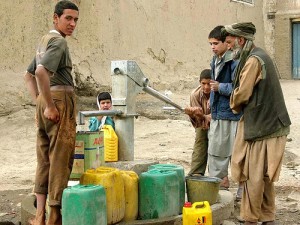 Sa’ar Stream waterfall near the Banias: Israel’s natural beauty at its best
Sa’ar Stream waterfall near the Banias: Israel’s natural beauty at its best
Like other Middle Eastern countries, Israel continuously suffers from a chronic water shortage, which is most often seen in the water level in it’s historic water supplier, the Kinneret or Sea of Galilee. But due to above average rainfall this past winter (the Sea rose 2 meters!), Israel’s green areas, including the Galilee region and Golan Heights, are decked out in Mother Nature’s annual spring greenery and floral displays.
This lush beauty was revealed to us during a day long spring foliage tour to these areas this week.
 Ancient Katzrin Ruins: synagogue is in the rear
Ancient Katzrin Ruins: synagogue is in the rear
We began our tour by traveling through Wadi Ara, passing communities like Umm al Fahm, continuing into the Lower Galilee through some of Israel’s lushest agricultural regions, and past 588 meter high Mt.Tabor , which is often used as a “launch pad” by paragliding enthusiasts.
Upon reaching the Sea of Galilee, we were happy to see how high the lake had risen; former green areas and “islands” had again disappeared under the rising waters. We began our ascent onto the Golan Heights at the northeast end of the lake and continued on highway 87 toward what was to be our first stop on the Heights, the ancient archeological site of Katzrin which is now a regional park. The archeological excavations reveal an ancient settlement of Jewish scholars who lived there from the 4th to 7th centuries CE and whose inhabitants’ lifestyles have been recreated for park visitors.
 Katzrin synagogue, from within
Katzrin synagogue, from within
These include a house with furnishings, kitchen utensils and food storage, wine and olive presses, and a partial restoration of the community’s synagogue which also served as the community’s educational and social center.
Ancient Katzrin was inhabited by this community for 300 years and the inhabitants are said to have contributed to the compilation of the Talmud, the commentaries on Jewish Law that instructs Jews not only on how to observe their faith but which occupations to be involved in as well.
 Golan cherry trees in full bloom
Golan cherry trees in full bloom
We continued our journey through some of the Golan Heights’ pastoral regions where numerous herds of cattle could be seen as well as vineyards and orchards of fruit trees, whose pink and white flowers added a lovely touch to an already picturesque landscape.
Off in the distance, Israel’s highest mountain, 2,814 meter high Mt. Hermoncould be clearly seen, complete with remaining snow. Mt. Hermon, which is “shared” by both Israel and Syria, is actually a series of peaks of which the highest in Israel’s section reaches a height of 2,236 meters. As we neared Mt. Hermon, we passed numerous orchards owned by local Druze inhabitants, and stopped for lunch in the Druze town of Mas’ade.
 Mt. Hermon view from Druze village of Mas’ade. Some snow is still visible
Mt. Hermon view from Druze village of Mas’ade. Some snow is still visible
The Druze (read about Gamila and her soap)rely mainly on agriculture for their livelihood; but due to the growing number of restaurants and other business that have signs posted in at least three languages, Golan Druze appear to be interested in making money from outsiders. These include foreign tourists, Israeli day trippers and UN personnel.
The largest Golan Druze community, Majdal Shams, while continuing to attest their loyalty to the government of Syria, are interested making a Shekel off Israelis and other visitors. The town has a number of hotels and pensions, including the three star boutique hotel The Narkis that offers free Wi-Fi hookups, LCD cable TVs and even Jacuzzis.
The town also has a number of medical and dental clinics which appear interested in serving visitors as well. The road leading into Majdal Shams is now literally abloom with fruit tree blossoms, especially cherry and apple trees. And one cannot visit Majdal Shams without seeing the famous monument to its folk hero, Sultan al-Atrash, who led the Syrian rebellion against the French in 1925.
 Majdal Shams monument to Druze folk hero Sultan El al-Atrash
Majdal Shams monument to Druze folk hero Sultan El al-Atrash
Our last stop was the impressive Sa’ar Stream waterfall, located just east of the Banias nature park. The waterfall attracts visitors year round and Local Druze farmers take advantage of this beauty spot by offering local produce and Druze culinary specialties in a number of stands outside the entrance to the waterfall observation site.
Those more adventurous can descend a steep pathway to the bottom of the falls located in a narrow gorge some 200 meters below. The Sa’ar Stream is one of the tributaries of the Jordan River and most of its water comes from springs and melting snow on Mt. Hermon.
 Druze local produce for sale at Sa’ar Stream waterfall
Druze local produce for sale at Sa’ar Stream waterfall
After leaving the Golan we passed through the entrance to the Hulah Valley, through which run other Jordan River tributaries, including the Dan and Snir streams. The Hulah Valley runs parallel to the entire length of the Galilee “panhandle” and is Israel’s major migratory bird flyway, through which thousands of migratory birds including ducks, pelicans and storks pass annually.
While these areas are still green a visit to them is well recommended before they change color to gold and brown during the hot and dry summer months.
Read more about natural wonders in the Galilee and Golan Heights:
Sea of Galilee Rises Two Meters, But Still Runs Short of Water
Multimatrix Invests Millions in Israel’s Small wind Market
Enjoy Ecological Activities in Israel During Passover
The Hula Valley Gets Stocked as Birds Prepare for “Pelican Restaurant”



Always wanted to try cave-camping in Israel.